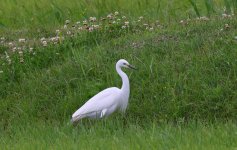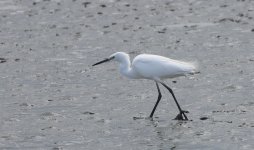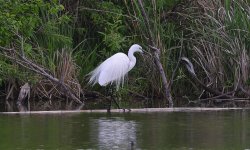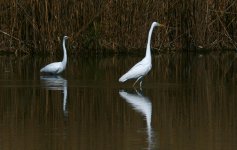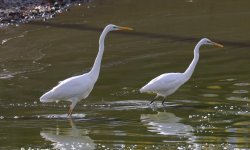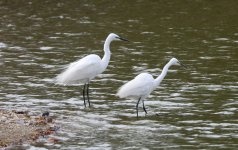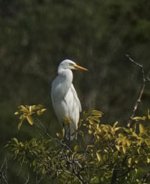johnallcock
Well-known member
Errr. Just to confuse things, I'm going to jump in to say that the bird on the right in photo 3 looks like a Great Egret to me, based on head & bill shape, neck length, and 'hunchback' posture. It's interesting that it looks so much smaller than the Great on the left - I'm not sure if that could be due to distance, individual size variation or subspecies differences.I am adding some further comments and photos just to complete the thread, or at least make it more information-rich.
===
Preface: I said in my original reply to James that Intermediate is a summer bird and summer is over. What I should have said is that in May/June/July they are around and breeding, and I don't see them later, but in September we still get a few (and locally a lot) of migrating individuals from further north - so, if it seemed that my comment suggested he couldn't have seen Intermediate last week, then I apologise.
===
The Japanese for these birds translates as 'Big Egret', 'Medium Egret' and 'Little Egret'. (I translate as 'Medium' because 'Intermediate' seems to more directly reference the bigger and smaller versions than the Japanese does.)
In my area, at least, if necessary when both are present, among birders alba is 'Big Big Egret' and modesta is 'Medium Big Egret'. As I said above, alba has become increasingly common in winter in recent years and where it was once something to get excited about, it no longer is particularly special.
Referring back to Butty's important point in #6, in our area, difficulty in judging an individual bird by size arises as a problem with differentiation between modesta Great and Intermediate in the summer, and this is when the 'eyeline test' is useful; alba is so much bigger than Intermediate that it would not be a problem.
I attach a few photos to illustrate.
Photos 1 and 2 show two Intermediates with a modesta Great.
Points to note:
The 'kink in the neck' theory of differentiation doesn't hold - both species can do both, although perhaps not as often as each other.
In the field at a certain season, the size difference, as Butty correctly says, is not apparent when only one species is present (and even then, crouching and general posture, especially when the birds are far away, can cause problems).
Photo 3 shows modesta Great on the left, Grey Heron in the centre and Intermediate on the right. Photos 4 and 5 show the eyline of the Great and Intermediate.
Points to note:
Mark Brazil's 'Birds of East Asia' says that modesta is slightly smaller than Grey Heron, and alba is slightly bigger, in general. This seems reasonable. The Grey in this photo is several metres in the background and the modesta in the front.
Again, the kink in the neck theory doesn't hold, as the bird on the right is Intermediate.
Looking at photos 4 and 5, even the eyeline can be difficult to use, as I said in my first post in this thread. While the Intermediate is obvious, the eyeline of the modesta Great is not so evident on this individual, because of wind/water or whatever, so if we saw just this bird it might not be evident which it was of Great or Intermediate. But with the larger picture available, we can make these judgements.
This post isn't challenging or supporting any other posts; I simply hope it provides some food for thought.
===
Postscript
I'd like to thank John Allcock for his post #9. Over the years, he has helped me a lot through his posts from near but not-the-same HK
View attachment 1530572View attachment 1530573View attachment 1530574View attachment 1530575View attachment 1530576
I've mentioned before in this forum that I personally find the gape pattern is confusing, hard to see in the field and not as helpful as is often suggested. I wonder if it varies geographically or if it's better considered as a one-way feature - a bird with obvious long gape should be a Great, but if you don't see a long gape it doesn't mean the bird is an Intermediate.
Once you're familiar with Intermediate they are actually fairly distinctly different (sorry, I know that comment doesn't help beginners or visitors!). I personally find structural features (head & bill shape, neck length & shape), behaviour (Intermediate tends to be in more vegetated, marshy sites) and plumage (adult Intermediate usually has longer plumes on the breast) to be useful features. As MacNara mentions above, confusion with (Eastern) Cattle Egret can be as much a problem as confusion with Great.





